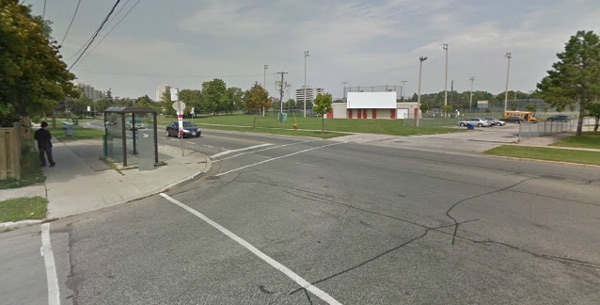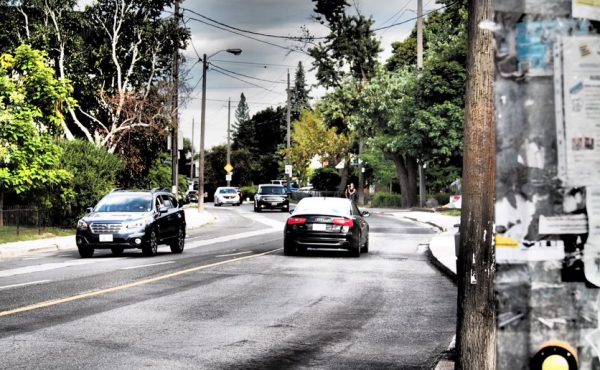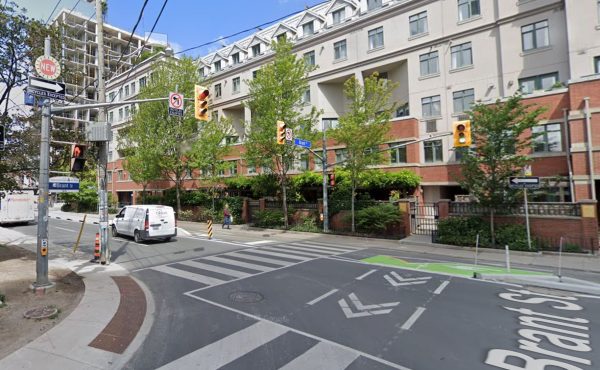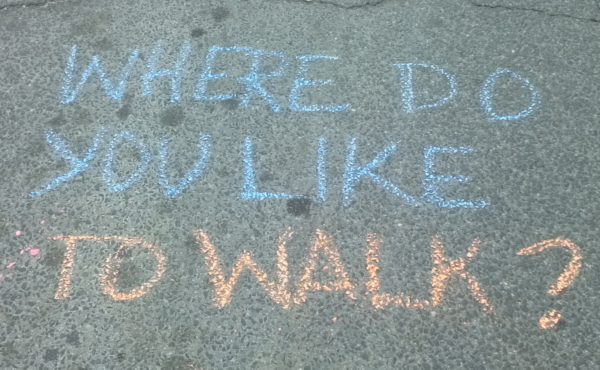As is so often the case, it has taken a tragedy to get politicians talking about improving walking safety. This week, it was the killing of a high school student on the first day of school by a dump truck at the intersection of Sentinel Rd. and Lamberton Blvd (above). What’s more, it happened right in front of a middle school (Elia Middle School).
City councillor Gary Crawford, who recently saw a similar tragedy in his own ward, has taken the lead in calling for improved safety around schools. For one thing, he wants the city to look at the feasibility of banning trucks around schools when schools are letting in and out.
Meanwhile, in an interview on CBC Radio’s Metro Morning, Toronto District School Board chair Chris Bolton promised that the school board will take action to make it safer for students to walk to school.
These statements are promising, because until now the school boards have generally given the impression that they don’t think they are responsible for students until they arrive on the school grounds. And any action that can be done will need the City and the school boards to cooperate. But often, this kind of talk doesn’t end up leading to any action.
A simple first step would be to create a transparent process for parents and students who want to improve safety on their walk to school. Parents and students are the ones who know from experience where the dangers are (the Star reports that parents had been complaining about dangerous truck traffic at the intersection where the student was killed). But at the moment, there is no clear process for doing something about them. I have been approached a few times by parents who are trying to figure out how to move forward on this issue (I wrote up a brief guide on the Walk Toronto website). There needs to be a clear official contact point, an explicit process that gets set in motion, a set of people who will be involved from the City and the school board, and a set of potential actions and improvements (such as expanding crossing guards).
The school boards could also make it official policy to encourage active transportation (walking, cycling) to school, and commit to things like instituting walking schoolbuses and other elements of the Active and Safe Routes to School program in any school where teachers and parents show interest.
A commitment to active transportation would include making the teaching of walking and cycling safety an integral part of the curriculum for every school. It’s a simple, cheap step that would show that the school boards are serious about this issue.
The school boards could also work with the City to make school zones obvious and well-enforced. In theory speed limits are lower in front of schools, but no-one pays attention. What about painting something really visible on the road in the school zone, like a yellow grid, to indicate where vehicles must proceed with caution? It would be cheap yet highly visible. As well, some schools have instituted no-drop-off zones in front of their schools, requiring parents who drive their kids to drop them off a short distance from the entrance to the school where everyone else is congregating. Why not make these policies standard for all schools? They are just some of the ways that safety can be improved.
A final note: this week’s accident happened when the truck turned left at a T-junction. T-junctions are disproportionately dangerous for pedestrians (they figure heavily among the most dangerous intersections), as there are a lot more turning vehicles, and left turns are the leading cause of injuries to pedestrians, especially at the worst intersections.
Photo of the intersection of Sentinel and Lamberton from Google Street View.






3 comments
This crash was NOT an accident. It is physically impossible for it to have been accidental. It was due to negligence on the part of the truck driver. Yes, there was contributory negligence on the part of the City of Toronto by failing to provide safe infrastructure for children to safely walk and cycle to school.
NOT accidental, but 100% due to negligence. And therefore 100% preventable.
To prevent this totally needless death, the trip for children to go to school should look like this:
http://www.aviewfromthecyclepath.com/2013/09/the-school-run-in-assen.html
Here we have somewhere that actually cares about child safety. The contrast with Toronto makes me ashamed to be part of a society that puts mindless greed ahead of child safety.
The solution isn’t to ban trucks, at certain times of the day. The key is better overall driver training, and testing. Also better pedestrian training, anyone else remember Blinkly, the Toronto police car with big eyes or Elmer the Safety Elephant….